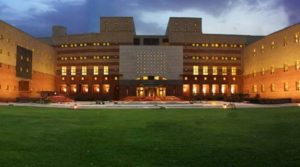In a first, IGNCA offers PG diploma in South-East (Agneya) Asian Studies
The classes for the first session of the Post Graduate Diploma in South-East (Agneya) Asian Studies took off at the IGNCA premises on August 6.
NEW DELHI: Following India’s increasing socio-economic proximity with the southeastern countries, the union culture ministry of India has decided to make more of its youths aware of the historical facts of related to the 11 countries falling in this region.
For this, the ministry’s Indira Gandhi National Centre for the Arts (IGNCA) has launched a one-year postgraduate diploma course in South-East (Agneya) Asian Studies at its premises in New Delhi.
The classes for the first session of the Post Graduate Diploma in South-East (Agneya) Asian Studies took off at the IGNCA premises on August 6.
Prof. Ganganath Jha, Jawaharlal Nehru University (JNU) delivered his address during this session.
The course will concentrate on the historical aspects of the pre-Christian era and India’s influence on those 11 countries, on their art and culture.
“The idea is to highlight the ancient glory of India and introduce to the Indian youths Jambudvipa. India has about 550 universities but Southeast Asia is taught in very select ones. And wherever it is taught it’s about contemporary history or modern South-East Asia. But our relation with South-East Asia has been very old, our people migrated and settled there, influenced their culture, tourism etc,” said Prof. Bachchan Kumar, In-charge, South-East Asian Studies, IGNCA.

The two-semester course will consist of an outline of South-East Asia, its geography, sources of study, Austro-Asiatic civilization, Ethnological, Pre-history, causes and theories of Indianization etc. The course will also touch upon its political history from the early period to 1500 AD, and cover Kingdom of Funan, Chen-la, Angkor, Champa, Dwarawati, Sukhothai, Pagan, Sailendra, and Sri-Vijay. It will also touch upon the subjects like Religions in South East Asia such as Saivism, Vaisnavism, Vedic traditions, Theravada, Mahayana Buddhism, Confucianism, and Islam.
The Language and Literature in South East Asia to be covered in the course would include linguistic Introduction, Sanskrit words in South East Asia, Indian Literature of Cambodia, Indo-Javanese Literature, Ramayana and Mahabharata in South East Asia, Oral Literary traditions in Indonesia.
“We at IGNCA will touch the classical aspect, culture and history of Southeast Asia not the contemporary. What connected we as India has been with all 11 countries since ancient time. Even before the Christian era, but what we will teach here is the Funan era, the first century. The Indian Kingdom went on till 5th century. The Chen-la Kingdom took over from 550 to 700. The Angkor kingdom followed up to the 14th century from 750 century onward. It was during that time Angkor Wat temple in Cambodia. It was constructed by Sujvarman II around 12 century. This temple has a width of 1.5km and length 3.00kms. The carvings on the 6 panels have Ramayana, and Mahabharata impressions,” Prof. Kumar added.
The second semester will cover Cultural Synergy with subjects like Dongson Culture, Ancestral worship, Devaraj Cult, Saiva Siddhant in Indonesia, and Festivals, Tattoos, rites and rituals, and also Art and Architecture in South East Asia Dvaravati art, Sukhothai art, Pagan art, Khmer art, Indo-Javanese art, Architectural patterns of the Borobudur stupa, Prambanan temple , Mison temple, Angkor Wat, and Dieng temple.
Other subjects like Social set up, Kinship, Kingship, Dress, Ornaments, textiles, Musical instruments, Cultivation, irrigation system, Food and drinks, Sculptures, Mural paintings, Wayangkulitpurwa, Javanese dance, drama, Karnas of Prambanan and Mask performances will also be covered in the course.
“We had influenced the cultures of the entire world including countries like Laos, Cambodia, Philippines, and others were all ours. That is what we are going to teach our young generations. And southeast Asia was known as Swarna Bbhumi or Swarndeep. And it was known as Agneya Asia as it was situated on Agneya cone,” said Prof. Bachchan Kumar.


